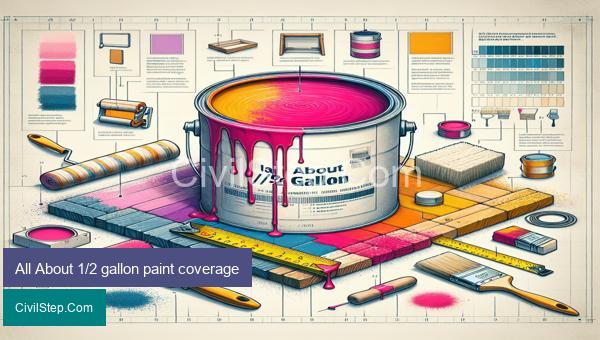
Choosing the right amount of paint for a project can be a difficult task, especially when considering variations in surface texture and paint quality. One common measurement used in the paint industry is 1/2 gallon, which can cover a wide range of areas depending on these factors. In this article, we will delve into the concept of 1/2 gallon paint coverage and provide a comprehensive guide on how to determine the right amount of paint needed for your next project. Whether you’re a DIY enthusiast or a professional painter, understanding the dynamics of 1/2 gallon paint coverage can save you time, money, and resources. So let’s dive in and uncover all there is to know about 1/2 gallon paint coverage.
1/2 gallon paint coverage

Paint coverage is the area that can be covered with a certain amount of paint. In the construction industry, paint coverage is an important factor to consider when planning and budgeting for a project. As a civil engineer, it is crucial to have a good understanding of paint coverage to ensure efficient use of paint and cost-effectiveness in projects.
The coverage of paint is measured in terms of volume, usually in gallons or liters. However, in some cases, paint coverage can also be measured in terms of area, such as square feet or square meters. For convenience, most paint cans come in standardized sizes, such as 1 gallon or 5 gallons.
In this article, we will focus on the coverage of 1/2 gallon of paint, which is equivalent to 1.892 liters. The coverage of 1/2 gallon of paint can vary depending on several factors such as the type of paint, surface to be painted, and application method.
Firstly, the type of paint used plays a crucial role in determining the coverage. Some paints, such as primer and flat paints, have a higher coverage rate compared to gloss paints. This is because of the difference in the amount of pigment and binder present in the paint. As a general rule, the higher the pigment content, the better the coverage.
Secondly, the surface to be painted also affects the coverage of paint. For example, porous surfaces like bare wood or concrete tend to absorb more paint, resulting in a lower coverage rate. On the other hand, smooth and non-porous surfaces like metal or previously painted walls require less paint and have a higher coverage rate.
Finally, the application method used also affects the coverage of 1/2 gallon paint. Usually, roller and brush application tends to use more paint compared to spraying, resulting in a lower coverage rate. It is essential to consider the level of expertise and techniques involved in each application method to achieve the desired coverage.
On average, 1/2 gallon of paint can cover approximately 200-250 square feet of a smooth surface with two coats of paint. However, this coverage may vary depending on the factors mentioned above. It is always best to refer to the manufacturer’s guidelines for specific coverage rates for a particular type of paint.
In conclusion, as a civil engineer, having a good understanding of paint coverage is crucial to ensure efficient and cost-effective use of paint in projects. Other than the factors mentioned above, climate conditions, paint thickness, and the condition of the surface to be painted can also affect the coverage rate. Therefore, careful planning and consideration are necessary when estimating the amount of paint needed for a project to avoid any potential wastage.
Conclusion
In conclusion, knowing the coverage of 1/2 gallon paint can save you time, money, and effort when tackling painting projects. By understanding the factors that affect coverage and utilizing helpful tips and techniques, you can achieve optimal coverage and achieve a professional-looking finish. Whether you are a homeowner or a professional painter, being knowledgeable about 1/2 gallon paint coverage will make your painting experience more efficient and successful. With the right tools and preparation, you can confidently tackle any painting project, big or small, with the assurance that you have a thorough understanding of 1/2 gallon paint coverage.
